Main CB500X RR Index page


Rally Raid have refined the CB500X RR a lot since I rode mine. See here.
Set up
RRP Level 3 kit plus accessories as below.
Final weight
221kg (487lbs) plus 25kg transit/15kg piste payload. Me, about 105kg in gear.
Where
UK to southern Morocco leading fly-in tours, plus solo riding.
Honda’s CB500X came out in 2012, an adventure-styled road bike in a range of three new CB500s (below) using a smooth, slim and economical 471-cc motor. It was pitched as an inexpensive and unintimidating first big bike to suit the L2 power-to-weight license category in Europe. You probably know all that – if not there’s more about the CB-X’s origins on my intro page.
Possibly having clocked the 500X-based Thai rally racers, Rally Raid Products in the UK spotted the potential to upgrade the 500X’s twin-cylinder platform into a budget, all-road travel bike by improving the suspension and increasing the front wheel size. You can read about the full development process here.
To prove the concept, in 2015 Dakar Rally rider Jenny Morgan (whose original idea it all was) rode the Trans-Am Trail there and back. Around the same time, three levels of RRP kits were released, with L3 giving you the works: more travel, spoke wheels and a fully adjustable shock.
In a way the CB500X RR is a 21-st century Kawasaki KLE500 (left). Other comparisons include Honda’s Transalp, Yamaha’s XT660Z Tenere, the 650 V-Strom and the BMW F700GS (formerly 650GS and now a 750GS – I’ve tried them all!). All bar the XT are mid-sized twins which make great travel bikes: smooth, comfortable long-distance machines that can handle a rough track while carrying loads and eating up the miles without eating fuel.
Many of those bikes are based on old designs, but the 500X uses a modern engine that’s smoother than a Tenere, more economical than a Transalp and physically smaller than a V-Strom or 650/700/750GS. And it’s cheap too: £5k when it came out with plenty of used examples at £3500 when I was looking and now from £2500. Service intervals are 8000 miles.

Stop me if you’ve heard this before, but I’ve long believed a parallel twin of around 500cc makes an optimal do-it-all bike in what the AM Zone where realistically you’re dealing with imperfect roads and gravel tracks, rather than pristine highways punctuated with fully franchised service areas, or barely rideable BAM-style challenges.
Years ago I modified a Suzuki GS500 to test this 500-twin idea, I ran a 660 Tenere for a bit, was lent a BMW F650GS just before it became a 700, and in 2015 briefly looked at a TDM900 and a 650 Versys before buying myself a 2014 CB500X which ended up like this:
The Honda
In its standard form, the Honda is a pleasant machine that handles, brakes and goes as nicely as the people you’re likely to meet on it. Alongside a 750GS or V-Strom, it’s a compact bike that’s easy to manoeuvre in traffic and manage on the trail. For its performance potential, it’s also the most economical bike of its size I’ve ever owned. Up to 90mpg (75 US) is possible pootling along Moroccan back roads and, as with many bikes, there’s a 20% improvement in economy if you stick below 105kph (65mph). The worst I got was 57mpg in north Spain where it seems the winds are forever in your face, the litres short or quite possibly, running heated gear draws power and so costs fuel. Inspect the full fuel record here.
Are small bikes really more economical?
CB500X vs CRF250L
• 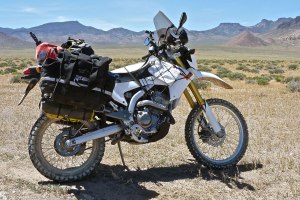 Capacity: 250cc vs 471cc
Capacity: 250cc vs 471cc
• Claimed power: 24hp vs 47hp
• OE wet weight: 146kg vs 197kg
• My cruising speed: 60 vs 70-75mph
• Service intervals: 8000m
• Alternator output: 337w vs 500w @5000rpm
• Av. fuel consumption: 86.7mpg vs 74mpg
• OE tank max fuel range: 140m/270m
• Cheapest eBay summer 2020: 2016/2k/£3000 vs 2013/31k/£2500
My 2012 250L’s fuel consumption may have been some 15% better (once I retuned the fuel controller), but the point of this comparison is that I bet if I’d run my 500 at the 250’s speeds I’d have got similar results. On a 500 you get the choice: it’s largely immune to gradients, headwinds, loads or your impatience. At times on the 250, I was stuck at 55-60 with nothing left for overtaking which in its way can be quite tiring.
The 250’s true benefits are clear: include lower purchase price and insurance, and above all the much lighter weight which makes it unintimidating off-road. You just pay for it on the road. Me, I’d love to see a CRF450L and I’ll keep saying that until Honda make one. In 2018 they did. Oh dear…

Apart from being a great value machine, fuel consumption is the 500’s outstanding feature. It must all be down to the internal efficiency of tractable motor, and perhaps the bike’s slim frontal profile. For normal bike riding in today’s traffic conditions I really can’t see the need for more power other than the thrill of annihilating other traffic. For an ostensibly bland 180-degree P-twin, the X sounds good and looks great.
The more I think about it the more important light clutch operation and a slick gearbox contribute in making a bike enjoyable to ride. With its long link rod the ‘box isn’t as good as the ancient TDM I ran a year back, but the six gears were spaced just right for my usage. On the road, I rarely had to change down to overtake so perhaps the gearing is on the low side for road-only riding. Some say raise the front cog one tooth to 16T. I admit I frequently try to click up from sixth, but then it’s only a 470cc.
Brakes I’m beginning to think are nothing special – again my aged TDM with 50k on the clock showed the way. Like other things it could be down to the Honda’s budget spec: softer pads or less flex-prone braided hoses might make a difference. There’s still 3-5mm left in both pads at 8000 miles, so I imagine they’ll last till 12k+. I had no issues with the ABS on the dirt. If that ever was a problem then it’s now largely become an urban myth with modern ABS systems. My front brake has developed a low, sonorous, foghorn-like squeal as I come to a halt. I quite like it.
As expected, the suspension was similarly basic but functional, especially up front. It gets the job done but will be overcome by high speeds, heavy loads or rough roads. Having said that, I wasn’t so desperate as to look into adjusting the original shock (no tool supplied).
The Pirelli Scorpion Trail tyres are amazing, wet or dry, and for a small road bike the comfort is as good as you can expect for me at 6′ 1″. Sometimes it tingles at higher rpm; sometimes it’s completely smooth (with bar ends removed). The mirrors give a great view of my shoulders, like bike mirrors have done in all the decades I’ve been riding. The switchgear was intuitive and with a good feel and for its size, the dashboard (above) was among the best I’ve had on a bike until I got my XSR: fuel level; time; trip; speed and rpm – all I want to know except mpg and temps and legible at a glance. As long you keep pressing them, the two-button mode/set combination is also intuitive enough without the humiliation of referring to the manual.
The bike used no oil (changed with filter @ 6000 miles) or coolant; no bearings have worn out as far as I can tell. It starts and ticks-over at a steady 1222.22 rpm, sounding just like it did the day I bought it. Not a single Honda thing broke or came loose, unless you count the excess load on the twin fairing mounting bolts on the headstock (left). As RRP recommend, fit M8 nylocs here (and the chain adjusters too), even if it means adding a 13mm to your toolset. Overall, for what it costs and what it does, as it comes out the crate, the 500 gets a big tick.
My accessories
My four-year-old Barkbuster Storm handguards went on with the usual small fitting and clearance limitations. They were handy for leaning the bike on walls and cliffs when the RRP sidestand broke, though never got tested in a fall. It meant I didn’t need to fit the shorty adjustable levers which RRP supplied.
A Palmer Products windscreen adjustment bracket with the taller Honda screen gives variable height plus three tilt angles, but I can’t say it transformed my ride into a cocoon of still air – I’m out in the wind on a motorbike after all! Its value is as much in keeping the chill, pelting rain and windblast off you. Due to its leverage, and to spare the fairing-mount bolts I removed the screen during the tours.
Daytona heated grips (new, but several years old) were great in northern Spain and on chilly High Atlas mornings. They mean you can wear less thick gloves. Compared to Oxford grips I’ve used recently, they’re not as hot and whole design is like something from the 70s (effectively ‘on’ or ‘off’) but they’re dead easy to fit.
Aerostich Sheepskin Saddle Pad.
Had this for years – on its 3rd or 4th bike by now. One day in Morocco I took it off and paid the price within a 100 miles (it’s possible the Honda seat foam had crushed-out by now). It does nothing more than take the edge off a long day without looking too much like a dead animal. I thought it too had crushed out, but a quick wash with some hotel room shampoo and it was good as new. Yes, it gets wet but dries quickly with a quick rub.
Tutoro automatic chain oiler.
Also a successive fitting, Tutoros pump oil using a balanced weight suspended in the reservoir: when the bike’s in motion it pumps according to your adjustment; when at rest, it stops. I thought the snake-tongue feed to the sprocket would get knocked off on the piste, but with the more rigid mount, it’s still there. It’s a sorry sight the way the oil picks up sand and grit on the piste, but there’s no way around this other than a full wipe down then running dry. As we’re on and off the piste all day that’s not practical, so I let it go and cleaned between tours. The JT x-ring chain seems to be hanging in there: three adjustments in all that time (ie: one more than normal, according to past experience).
Luggage. A last-minute, cobbled-together set-up once I realised my Magadans wouldn’t fit on the RRP side racks. In fact, it all worked surprisingly well, but I was hotel-based. What I needed access to was in the blue ME holdall, the Touratech tail pouch or the ammo pouches on the crash bar. One dry bag carried camping gear that was never used, the other 15-year-old SealLine picked up a nick that’s easily fixed with Aquaseal. The ME holdall doesn’t claim to be waterproof so inside was an old model Watershed UDB. It didn’t rain on the whole trip.

Tyres I’m running out of new tyres to try in the sizes needed so I fitted an ageing but unused Keidenau K60 on the front and Golden Tyre GT201 150/70 R17 TL 69V on the back. No complaints as expected, though the stiff and huge 201 felt like overkill for the little, 47-hp Honda and, as you’ll have read, was hard work to fit on the BARTubeless rear rim. Five thousand miles in, the rear GT looks less than half worn and the front K60 less than that. Much of this must be down to cool tubeless running at high pressures (‘as high as possible; as low as necessary’ – who said that!?), as well as the engine’s even power delivery which lays down velcro-like traction rather than elbow-separating torque.
For the clothes I wore, see these jackets and this heated jacket.
Rally Raid Level 3 kit and other RRP bits
FYI: some RRP bits I bought, some RRP supplied in exchange for an ad in AMH7
My bike only got the L3 kit (left) fitted a couple of days before I left for Morocco. The job took about four hours at RRP’s well-lit workshop. I dare say it’d have taken me as many days of intermittent roadside blundering. In the preceding months, I’d fitted the RRP bashplate, racks, footrests, rear brake guard and, to save time in the RRP workshop, the top triple clamp which became a bit of a faff.
The L3 kit then costs £2200 which, for what you get, is actually pretty good value, especially if you can get a used 500X at a good price.
RRP pannier and tail rack
The RRP side racks are an ‘unrectangulated’ design similar to what RRP produce for the subframeless 690. They’re designed for soft baggage – or not designed for hard luggage – and rely largely on the strength of the mount plates and thick tubing, rather than opposing forces supported by a cross-brace behind the number plate. Unlike the 690, the 500X has a meaty subframe on a par with an XT660Z so could manage with a lighter supported rack. The tail plate-rack is a CNC job that’s become common these days.
For my sort of use, at a total of 6.5kg I found the racks very easy to fit, but probably heavier than a conventional tubular rack, even if hang out so far back they’re in another time zone.
It looks neat, slim and minimal – and the side racks may suit shallow, weight-spreading throwovers like the recommended GL Siskiyous. But they were too shallow and slim to take my lower-hanging Magadans. The fat, upswept pipe also gets in the way, as it did on my GS500R. (To retain a slim profile I got it surgically lowered).
Fitting the tail plate meant losing the useful Honda grab rails (saving 1.8kg. I made my own from a belt). There’s plenty of room behind the side racks for tool tubes – a great idea though not something I’ve tried yet. On my trip, I just stuffed a 10-litre fuel bag and some inner tubes in there.
While waiting for the boat back from Santander I noticed the LHS side rack looked bent inwards perhaps a centimetre at the right angle plate (barely discernible left, but notice the lean out in the chain oiler reservoir). The only time the bike fell was when the original sidestand broke, and even then I partly cushioned the fall. It suggests that, not surprisingly, even with soft bags the design at that time wasn’t up to a static drop, the in-out bouncing of luggage, let alone a crash.
I was interested to try this unsupported rack idea, but the fact is you need more meat in the metal to make it strong: = more weight. Next time round I’d go back to a conventional, cheaper, stronger and lighter cube-tube rack or none at all.
RRP bashplate/crashbar
At 3kg and £200, this is a heavy bit of kit in steel plus a few thin alloy plates, but it protected the vulnerable sump and cat and is something every bike of this kind needs unless you like dealing with this or even this. I never heard or felt any dramatic clangs on the piste, and an inspection underneath revealed no gouges. The integrated crash bars make handy mounts for ammo pouches – useful as my last-minute baggage set-up lacked exterior pocketing. The bashplate’s flat base makes a stable platform for supporting the bike.
For oil and filter changes, undo the front oil filter guard plate, then release the pin through the centre-stand mount at the back of the bashplate (early pins were a tight fit – remove the paint and grease liberally). Let the bashplate pivot down on the front engine mounts (you don’t want to mess with those any more than once) – the 14mm drain plug is right there on the LHS and once undone will spurt out past the plate. Here’s a video.
RRP rear brake reservoir guard
Still there and undamaged so probably worth it for the odd stray stick or stone that could ruin your day.
RRP XL footrests
Solid grip, great support and no more vibration than OEs, despite their rubber caps. I thought this was a bit of bling on anything other than a full-on dirt bike, but now see they’re definitely a worthwhile add-on. They’re also a little lower (left) than the originals which is a benefit for aged knees.

RRP elongated sidestand
The two-inch suspension lift requires a longer sidestand – RRP copy and elongate the original design. A harsh lashing down on the outbound ferry bent the stand just below the pivot (left). I nursed it but it broke two days later. Kicking it back out of the way, I was surprised how thin the tube walls were – it didn’t have much heft to it. RRP promptly send out a reinforced item.
I remained wary but so far so good. I actually think an equilaterally stiff round tube with a thicker wall would be a better long-term solution to the greater forces exerted on the longer RR stand, as well as a wider foot for soft terrain. When a side stand is all you have, it needs to be bombproof.
RR now make stronger sidestands.
RRP triple clamp and fork kit
As you can read here, RRP perform a major makeover on the basic OE forks whose main attribute is that they have a chunky 41-mm diametre. The extra height giving 170mm of travel is achieved by fitting a dog-legged (or is it gull-winged?) top triple clamp so the fork top sits a little lower, as well as doing something inside the tubes, all to make room for the larger diametre wheel. Inside they fit full-length linear springs (in three rates; assume I got the heaviest) plus new damping rods with a shim stack (a form of cartridge emulation?) plus thinner oil.
My contribution to the party: a nice pair of floppy rubber gaiters. The forks get preload adjustment as well as bleed valves on the tops, and after Tour 1, I cranked them up a full turn and a bit. With the back-end similarly jacked up, that was a great improvement on the piste, but I can’t say the action on small, sharp-edged bumps (stones and rock ledges on the piste; pothole edges on the road) matched that of my old Hyperpro-shod, USD-forked X-Country. It’s probable that running the front K60 at no less than 26psi (it being tubeless on a non-tubeless rim) may have contributed to the harsh response to sharp edges. Also, the XCo was 30-kg lighter with 220mm of travel up front, but with no adjustment, and it ran on the same terrain on similar tyres at the same pressures. On the road, there’s not much in it but when combined with the HP shock, it was probably the best suspension I’ve just off road since my IT250J.
Discounting the fickle eye of the beholder, as of just now I’ve unearthed three-and-a-half actual reasons why USD forks are better than RWU: less deflection (fatter ø tube near the fulcrum); reduced unsprung weight; more travel (hard to work those two out), and it’s said, most USDs are cartridge (long story; look it up). The other difference is Hyperpro progressive springs.
Despite the few similarities on these two bikes and their use, all that adds up to probably too many variables to make a useful comparison other than one felt better than the other. State-of-the-art USD may be best, but fitting a set on the budget-oriented CB-X is OTT and the RRP makeover is a huge improvement for the money. It’d be interesting to try out progressive fork springs on the CB500X, as – depending on who you ask – the theory is they deal with small and large as well as fast and slow better than linear. And while we’re having an argument, Mac is better than PC, hands down! Since then I met Jenny and John in the Pyrenees (left) and hear they’ve developed a cartridge fork for the CBX.
The RRP top clamp raises the OE bars, but not enough to make standing up comfortable for me. That could be fixed by pivoting the bars forward, but then the Storms would hit the clocks which they only just clear. RRP have just produced some risers for fatbars, (left), but because fatbars are lower than the OE steels (right), I’m not sure it would make a great deal of difference to the overall height – a stronger bar would be the main benefit. For more rise, you then need to get into longer cables and wiring, because you’re trying to make a trail bike from a road bike.
Since this report was written, in response to customer demand RRP have manufactured an ABS switch (left) to allow you to switch the ABS on or off on the move.
Some people believe ABS can be a liability on the dirt, where it reduces braking distances or limits the ability to lock the back up and ‘rear wheel steer’, if you have that skill level. That may be the case on some bikes, but I must say I never found the ABS to be a problem at the typical speeds I rode this 220-kilo Honda on the dirt. Until I rode a Husky 701.

RRP replacement mudguard
If the unmarked state of the radiator is anything to go by then this mudguard – forget what it’s from, a Transalp – 650 BMW? – does a great job. It looks like it’s part of the original bike but front and back has significantly more coverage (right). And though I never encountered any thick clay which blocked up the tyre. I’m told it’s a two-tool job to remove it.

RRP rear shock
Though it only has 170mm to work with, the longer Tractive shock (below) gives you a full range of adjustments – no less than four settings to juggle, plus your variable loads and of course, the terrain. While obviously an improvement over the original, 2000 miles in I increased the as-delivered preload and damping settings quite a lot to get a good ride most of the time. Again, I felt the similar Hyperpro shock on the XCountry gave a superior response and control (165mm – nearly the same as the CB-X RR) while the Tractive was similar to the F650GS. The big difference is both those BMWs had an accessible remote preload adjustment (PLA; a knob): to improve the ride, crank the knob. Easy.

Tractive do make hydraulic PLAs, but originally on the 500X unit there wasn’t enough room to fit one that would be up to the task. I was also told the short Honda spring might cause coil binding if it was excessively preloaded, though you’d think that’d be easy to limit.
The lack of an RPA means the full potential of the sophisticated and costly Tractive shock was difficult to realise without removing the LHS footrest hanger and faffing around a few degrees at a time with an allen key on a ring spanner (the supplied, multi-bit Tractive tool won’t fit, though it works the damping dials fine). That’s OK to get the preload in the ballpark, as I did by adding 2.5 turns (right; about 60% of the way down the threads), but not for tweaking on the road as conditions change. As I said in a post somewhere, it’s all the wrong way round on this and most shocks: a travel bike primarily wants easily accessible preload adjustment – I suspect your fancy damping controls only really matter to racers. Once set, I never touched my Hyperpro XCo’s three damping settings.
Rally Raid now offer a hydraulic RPA for the CB-X RR, right
I do feel siting the shock’s remote reservoir right alongside that hot, lean-buring engine is not a great idea. Whatever’s in there, gas or oil or both, the point of moving it away from the shock body is to keep it cool so the damping doesn’t fade.
Though it could be a case of imagining what you’d expect to happen, I’m sure on some warm, 25°C-days crawling up a rough track at little more than walking pace and with the radiator fan whirring away, the shock’s action went off and got more bouncy – ie: reduced damping effect.

I read that Tractive told RRP mounting the shock by the barrel shouldn’t be a problem, but that seems counter-intuitive. A more conventional position would be somewhere near the LHS pillion footrest (as on the XCo), and I can already see the reservoir would slot nicely into the corner where my Tutoro reservoir sat.
RRP came up with an alternative location for the remote reservoir on the RHS pillion peg (left).
Another thing I’d question are RRP’s spring rate guidelines as copied from here:
 They’re clearly guidelines – since revised, see below – but at 95kg (210lbs) should I be written off as morbidly obese? Who knows, but by the time I’m dressed in a combination of winter and off-road biking gear (and have scoffed a few meat pies) I’m already right in the max, 120Nm spring category (as fitted on my bike). And this is before I load my bike up with 15-25 kilos of gear. I presume the added weight of the L3 kit is taken into account, as with racks and protection and other bits, my bike is about 24kg heavier than what I bought. That’s to be expected: any travel bikes will make proportionally similar weight gains to be ready for overlanding.
They’re clearly guidelines – since revised, see below – but at 95kg (210lbs) should I be written off as morbidly obese? Who knows, but by the time I’m dressed in a combination of winter and off-road biking gear (and have scoffed a few meat pies) I’m already right in the max, 120Nm spring category (as fitted on my bike). And this is before I load my bike up with 15-25 kilos of gear. I presume the added weight of the L3 kit is taken into account, as with racks and protection and other bits, my bike is about 24kg heavier than what I bought. That’s to be expected: any travel bikes will make proportionally similar weight gains to be ready for overlanding.
Rally Raid revised their spring rate guidelines
A couple of road tests mentioned their Level 3 test bike (different set up from mine) felt on the soft side. I’d say if you’re pitching a conversion suited to overland travel (in the European sense) then for well-fed adventurists like myself, the RRP shock springs were a bit on the light side. I see the 500X RR as more of an all-road touring bike than a dirt road tourer. As such riders will load it up with hard luggage and racks and stiff, long-lasting all-road tyres (like the K60s I used).
Again, I hear that RRP may be considering firmer spring options.
Fyi RRP’s recommended rear settings are:
• Preload 11 turns from just touching free spring length with shock removed
• Rebound 12/24
• High-speed compression 7/18
• Low-speed compression 12/24
My settings for a pretty good ride without payload:
• Preload 2.5 turns from whatever it was on fitting (about 60%)
• Rebound 18/24
• High-speed compression 13/18
• Low-speed compression 17/24
It’s possible my high-speed compression (shock speed, that is, not ground speed) was set too high (13/18) to react quickly enough to sudden, sharp hits – and the stiff GT201 at >28psi may not have helped here. RRP recommend the cushier TKC 80 for their 500X conversion, a great tyre but for me not such a practical choice for long wear. Suspension should work with all kinds of tyres, though varying tyre pressures makes a huge difference to both the traction and the ride quality.
The rebound, though high at 18/24, feels about right which suggests it’s constraining a spring that’s already quite highly preloaded. Still, more experimentation needed here before the shock can get a fully qualified rating. I realise from watching Juan’s video below that in the rush of fitting it at RRP I never received the Tractive manual to go with the shock, only the tool. According to Juan below, Tractive suggest unloaded shock sag at 10% of total travel (1.9cm) and fully-loaded sag at 30% or 5.7cm. Use the spring preload adjustment to set the right sag.
On the whole, a stiffer spring will need less compression damping (otherwise it will feel stiffer still), and more rebound damping to stop the spring returning to its original length so quickly, and bucking the bike.Good explanation of rear suspension workings from CB500X-RR developer, Jenny M.
RRP wheels + BARTubeless sealing
In response to customer suggestions (including mine), tubeless spoked wheels was something new that RRP asked me to try out in Morocco. I’m pleased to say it went better than my DIY version on the Tenere. As you may know, I’ve been experimenting with this idea for years and BARTubeless seemed the best solution at the time. No air was lost on the trip but two months after, when I got the bike serviced, the shop reported that both Slimed tyres were at half pressure or so, so air loss at about a psi or two a week needs to be monitored. It could be the rim seal, the valve or the tyre carcass.
One limitation is the front rim isn’t an MT tubeless with the required ridges alongside the well to contain a tyre bead. That meant I was advised to run the tyre at no less than 1.6 bar (23 psi). Not wanting to risk spoiling my people’s holidays, I erred on the high side at 26psi which (as suggested) may have contributed to the forks’ poor response at low speeds. One solution would be to provide a tubeless front rim so it could be run down to 20psi safely.
The RRP rims themselves are probably overbuilt, but like a subframe, that’s not a bad thing for a travel bike as opposed to a rally racer. The spokes have not budged, and this was running rocky pistes where one abused XR came in with nearly every front spoke loose.
Besides the balanced suspension lift, the 19-inch front wheel is what transforms the Honda bike into a trail bike. For a travel bike I’m convinced a 19 on the front is the best compromise for road and trail. I wouldn’t even call it a compromise. On the back the 17-inch size is retained, though the wheel is actually heavier than OE by a couple of kilos. But again, for a travel bike where durability is vital, this mass is in the right place. The tubeless wheels are a solid and reassuring set up that’s now proven.
Summary
While my bike’s ready-to-roll weight (before luggage) has increased by over 10%, the RRP accessories including the Level 3 kit, as well as my own bits and pieces have increased the 500X’s all-road functionality by way more than that. I have some reservations about the suspension, but that could be down to my set up and could all be tuned out or has since been addressed by RRP. Running the standard bike on what we rode in Morocco would have ended in tears.
Surprisingly the bike’s added height doesn’t give an impression of top-heaviness – that must be something innate to a bike’s weight distribution. Neither was stability or roadholding affected in any way other than perhaps improving it. The ‘trail bike stance’ and the way it all looks like it was designed that way from the factory is the main benefit and biggest credit to the RRP kit.
Of all my recent bikes up to 2015 I’d compare the 500X RR with my old XT660Z (left) – similar economy and range, off-road utility and protection, but better build quality, a much lower centre of gravity, a smoother motor and better suspension.
The BMW F650/ 700/ 750GS (I’ve ridden them all) is quite a different bike – longer and lower and with a lot more power, but less nimble and much more expensive. It would be interesting to hop back onto a standard 500X as, suspension apart, that wasn’t such a bad bike either. On the left, the updated 2016 model.
I get the whole Rally Raid ethos to make the 500X into a functional all-road travel bike. A year or two later I implemented similar modifications to a vaguely similar Yamaha XSR700.







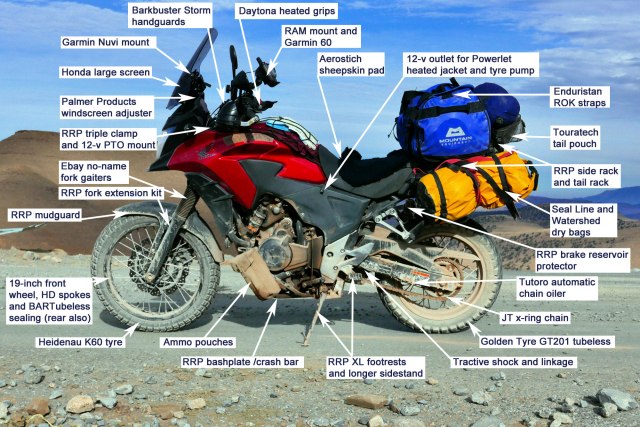
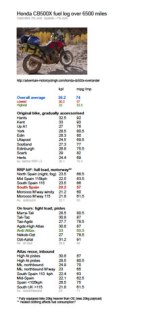







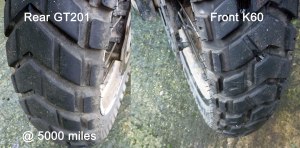








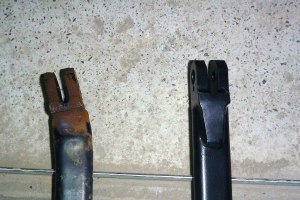
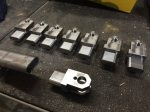
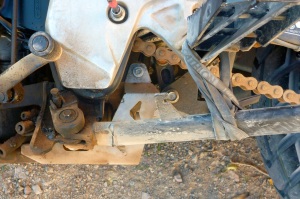
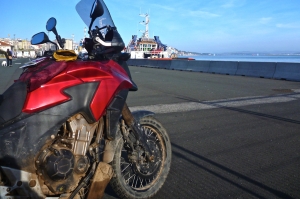




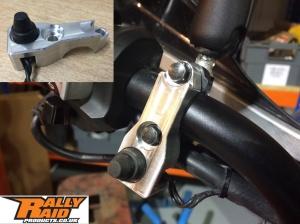

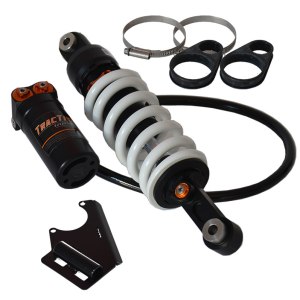
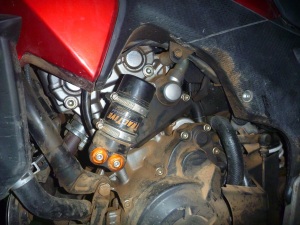

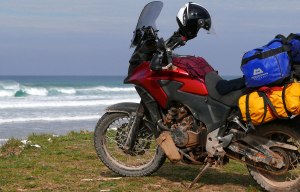

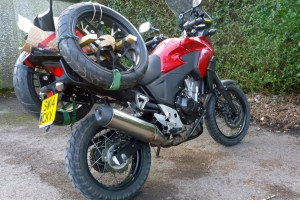
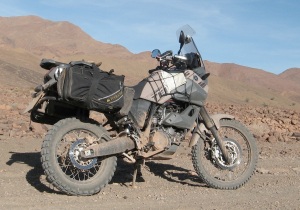



Chris me ol fruitcake that is one FANTASTIC blog thanks!!! I have several bikes and I just purchased a lovely CRF250 and goodness is it fun!!! Off road is wonderful and I previously had a stunning little Beta 200 plus a G450 BMW and loads of fun too. THANKS!!!
LikeLiked by 1 person
To be honest, I just stumble upon your page yesterday and now I spend a couple of hours reading and purely enjoying the bike reviews. Thank you very much for this honest and reality-tested review! The CB500X is on my shortlist together with the new Tenere 700 as a worthy successor of my (old but gold) Africa Twin 650.
According to you is it fair to compare the CB500X RR with the basic Tenere 700 if our goal is to prepare a bike for decent offroad adventure?
I guess that at the end of the day it would be cheaper to build up used CB500X with RR kit (with all the other goodies) than to buy bare naked T 700 for the same or even more money.
LikeLike
Hi Lyuben, glad to hear you enjoy the reviews.
There are lots of old 500s around now – and probably a few RR kitted ones too plus a few 19-ers.
I only tried a T7 briefly but enjoyed my XSR700 Scrambler.
The CP2 motor is so much nicer than the Honda, but yes you will pay double.
Realistically both are too heavy for more than gravel tracks.
Maybe start with the Honda and see if you like it.
LikeLike
Hi Chris
You are my size and very similar touring requirements.
But a lot of words to read. Could you list your best bikes and a rating system?
The cb500 seem perfect but heavy. DR650 seems to me to be best standard bike, if sourced in the USA.
My current rtw project is a cbf125 (tallscreen,nobodywork,cb125f forks & 18” wheel, 120/90 @ back) for lightness, economy & less 3rd world harassment.
Joe, Abbeyleix, Ireland & Twickenham
LikeLiked by 1 person
Hi Joe, your 125 could be all you need once you get out there. A lot to be said for low profile and running what locals ride. But most local riders out in the world are doing short trips, not crossing continents for months on end in all weathers so for me it would be too small for my weight and unnerving among the traffic, hills and wind of the open road.
I’d start from 250 upwards but, until someone makes something lighter or similar, a 500X does annoyingly tick all the boxes. They go from just 2500 grand. Never owned a DR650 but the only thing it’s got going for it is that its cheap to buy new. A 500X will be smoother and more economical.
As I say in the book, choose something that makes you feel good to look at- get on- and start up each morning, but which also will give you the confidence to tackle what you’ve asked of it. Whether that’s a ShingDong Roadhopper or something more conventional is up to you. It’s normal to be flummoxed by the choice so you just have to whittle it all down to your prefs.
LikeLike
One more things!Dear Chris!Can you tell me what oil brand you use for CB500X 2019 for long tour.I use oil “TOP 1 USA 10W30” when I go to tour.Thank so much!
LikeLike
Have to say i can’t remember. It was probably semi or full synthetic 10-40
LikeLike
Hi!Sorry for my English!I just buy new honda cb500x 2019!I want to add more 2 clearwater lights “Sevina”.Is it ok?
I want to know how much W alternator output ?
Thank so much!
LikeLike
The CB-X has a very powerful alternator – something like 500w so easily enough for extra lights and a lot more. Enjoy ur new CB-X
LikeLike
Thank so much Chris!
LikeLike
Pingback: Honda CB500 X long term review – 30,000 miles – Moto Compass
I see you compare the Tenere and CB-X RR. If you had to choose between these two which would you pick and why?
LikeLike
For my sort of riding I think I’d take the 500: similar or better mpg, smoother, lower seat, the weight is pretty similar and 19″ front will do me. Better build quality too and altogether a more modern engine.
A lighter T7 Tenere might change my mind, or better still, a WR-based 450 mini Tenere
LikeLike
your first comment caught my attention, lighter than a big thumper?? You need to recheck that. Just did a ride with 3 990’s and my 1190 ADV R and one of these, where we all liked it the rider was tall, 6’1″, 240 pounds, wrong tool for the job. I see this bike as a perfect setup for a shorter lighter person that doesn’t want the horsepower that a bigger bike will offer. We found ourselves riding slower to accommodate the bike with the heavier rider, not the bikes fault as I am sure a smaller lighter rider would have helped the situation.
LikeLike
“your first comment caught my attention, lighter than a big thumper?? ” Can’t see where it says that. I wish it was!
LikeLike
Hi Chris,
would you say just mounting the RR fork springs and rear shock would make the X a better road bike? Or do I miss the point?
LikeLike
Hi Rob, yes, I’m sure they would improve the X on the road, especially the forks which I recall were not so good. This sort of upgrade works well with many budget bikes because good suspension costs.
LikeLike
Hi Chris, Thanks for beating me to it . About a yearago I was looking at a CB500X and thinking I wonder if that would make a good adventure bike and then bought your book and found this brilliant resource. Test riding a CB500X this Easter and will go from there. My son is taking his A2 soon so it will suit him also. I like the look of the CB500r Rally Raid street scrambler as well. The R’s are very cheap compared to the X’s and apparently it takes the same kit from Rally Raid but, a 17 inch front spoked wheel not 19inch. What do you think?
LikeLike
Hi Steve, glad the book was useful and good to know the Rs are cheaper. I think if you’re not changing wheel size don’t spend on spoke wheels. You will gain strength but lose the tubelessness. I found the 19 front improved the feel of the bike. Maybe X fork tubes would slip in an R (I presume R are a bit shorter?)
LikeLike
Sorry I meant the F’s are cheap compared to the X second hand. Rally raid are doing a scrambler version of the CB500F which looks nice.
Really enjoying “The Street Riding Years”. Taking me right back to my rubbish FS1E and my TS125ER, which managed to shed about 1/3 of it nuts,bolts plus its petrol and oil filler caps on 1 ride from Cardiff to Southend in 1983. Your a very good story teller and I’ve laughed out loud several times. Finally, your earlier version of the AMH was a huge help when I got into off road riding in 2010 and took on the HUMM. For a sedentary 45 year old that was quite a leap. Thanks for all of it – Brilliant.
LikeLike
Good to hear, Steve. Spread the word ;-)
LikeLike
Hi Chris, many links on the cb500x pages are broken, the url has an extra ‘h’ just before the ‘.com’
LikeLike
Thanks for the reminder Daniel. I thought I caught them all the other day. I guess a few slipped through ;-) Fyi delete the ‘h’ and you get there.
LikeLike
Yes, :) Anyway, great resource of information.. a Gold Mine actually! :) Thanks a lot for sharing your experiences!
LikeLike
Hi James, the problem was partly with the RR racks which were not high enough to support the already tall Mags, but also the high pipe. I presume a conventional rack like a Hepco might be better, but like I say, these Mags are tall which makes it awkward unless the pipeside rack frame sticks out. I had this on a F650 twin which resulted in throwovers well over a metre wide. One solution to retain slimness is to lower the silencer a bit as I did on my GS500 (search this site for a pic). The other is to get the pricey GL Siskyous which, being wider than tall, fit right in there.
if you look at the pic above of the CB-X lying on the grass, you can see that a Mag might fit if it was way forward and tilted a bit (other side doesn’t matter and velcro straps make it easy the mount asymmetrically like this. A heat shield (as on GS500 pic) on the silencer could mean the offside bag could almost sit on the pipe.
LikeLike
Hello Chris, have you found a way to successfully mount Magadan Panniers onto the CB500X at all? I’m shortly going to buy a used one to be RR converted and would like to fit these.
Thanks, James.
LikeLike